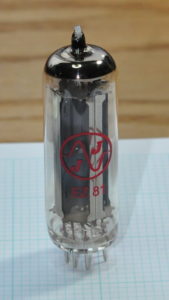So, this morning, I got a little reminder about the nature of the technology we all use. I currently have the 6EM7 Vertical Amp in my office at home connected to my computer sound card. When I reached over and turned it on this morning I got an interesting surprise.
The tubes started to warm up and then, suddenly, the JJ EZ81 rectifier tube lit up with a truly spectacular lightning storm. Arcs of electricity were jumping between the plates, the cathode, and the glass envelope with reckless abandon and much sound and fury. This lasted for a few seconds during which I could only sit and stare dumbfounded. Then suddenly all was quiet, the tube current meters started to rise, and the amp proceeded to start producing music. Needless to say, I reached over and turned off the amp.
So I removed the offending tube and replaced it with an Electro Harmonics 6CA4 I had sitting in my tube stash. At first I briefly thought about taking the back off the amp and doing some troubleshooting, but then thought better of it. You see, I knew the history of this particular tube. It has been in this amp since March of 2015 (over two and one half years) and in that time has experienced many thousands of hours of use and many hundreds of power cycles. This has been one of my favorite background music amps since I first built it. It has seen A LOT of use. Here is the little tube. Although you can’t see it in this picture, there is visible damage and charing to the cathode coating visible between the two plates and there is carbon deposited on the internal surface of the glass envelope. This little guy is clearly at end of life.
Here is the little tube. Although you can’t see it in this picture, there is visible damage and charing to the cathode coating visible between the two plates and there is carbon deposited on the internal surface of the glass envelope. This little guy is clearly at end of life.
JJ does random life testing on tubes for 5000 hours under nominal conditions or 1000 hours at maximum conditions. I don’t know exactly how may hours were on this tube but I would estimate at least 4000 and maybe more. Given that the manufacturer only does 5000 hour lifetime testing (and probably without a lot of power cycles) I don’t think this tube owes me anything.
So just a little reminder. Tubes are removable because they need to be replaced periodically. In a world of solid state micro-electronics with very high reliability numbers, we sometimes forget this. Tube testers used to be in every corner drug store and supermarket because they were so much in demand. Tubes needed to be replaced; and still do. But it doesn’t bother me at all. It’s just one of those things that make this endeavor different.

Aw, this was a really nice post. Finding the time and actual effort to generate a really good article… but what can I say… I procrastinate a lot and don’t seem to get anything done.